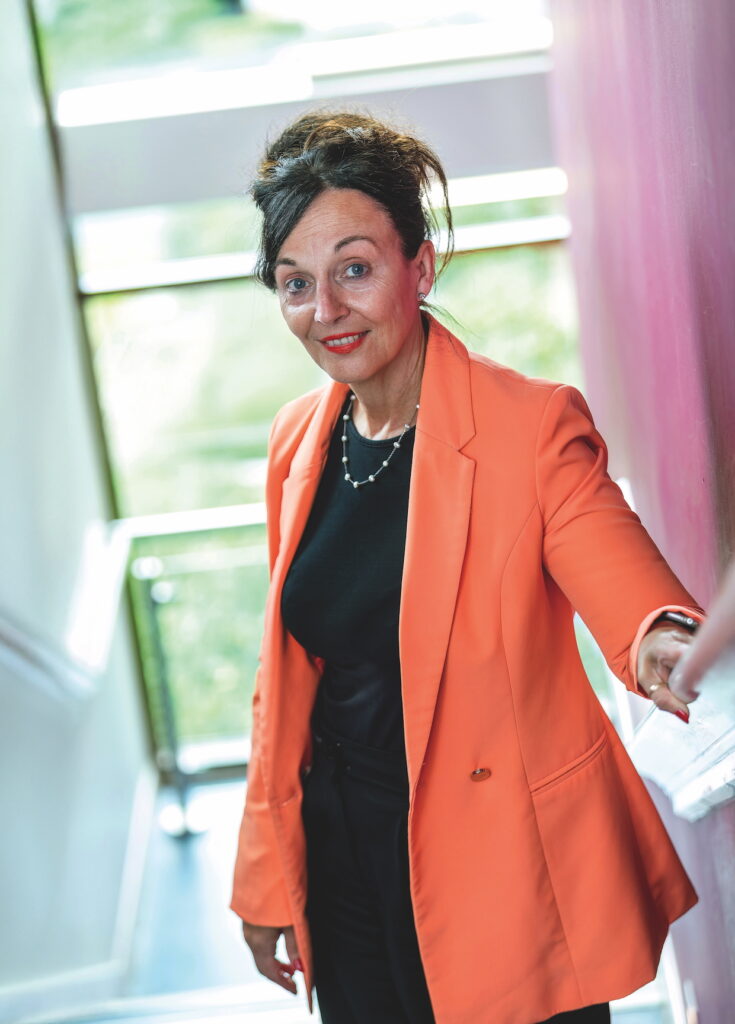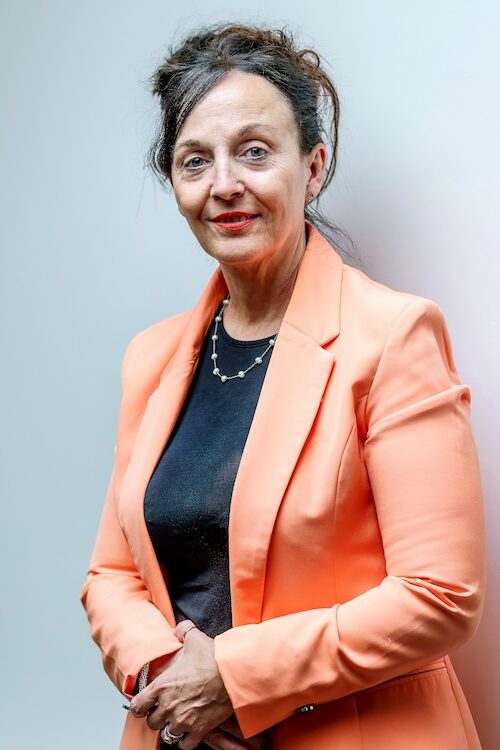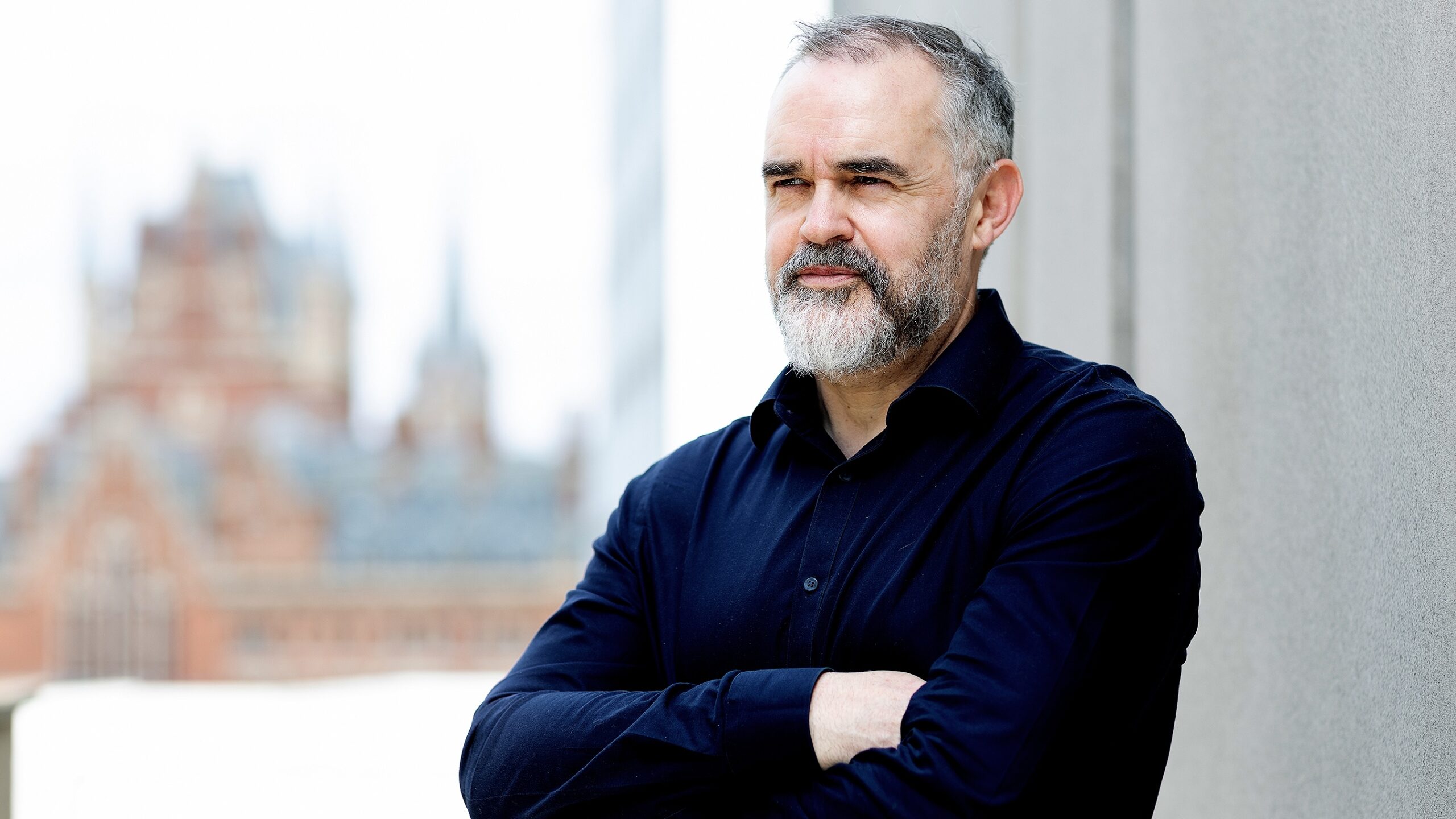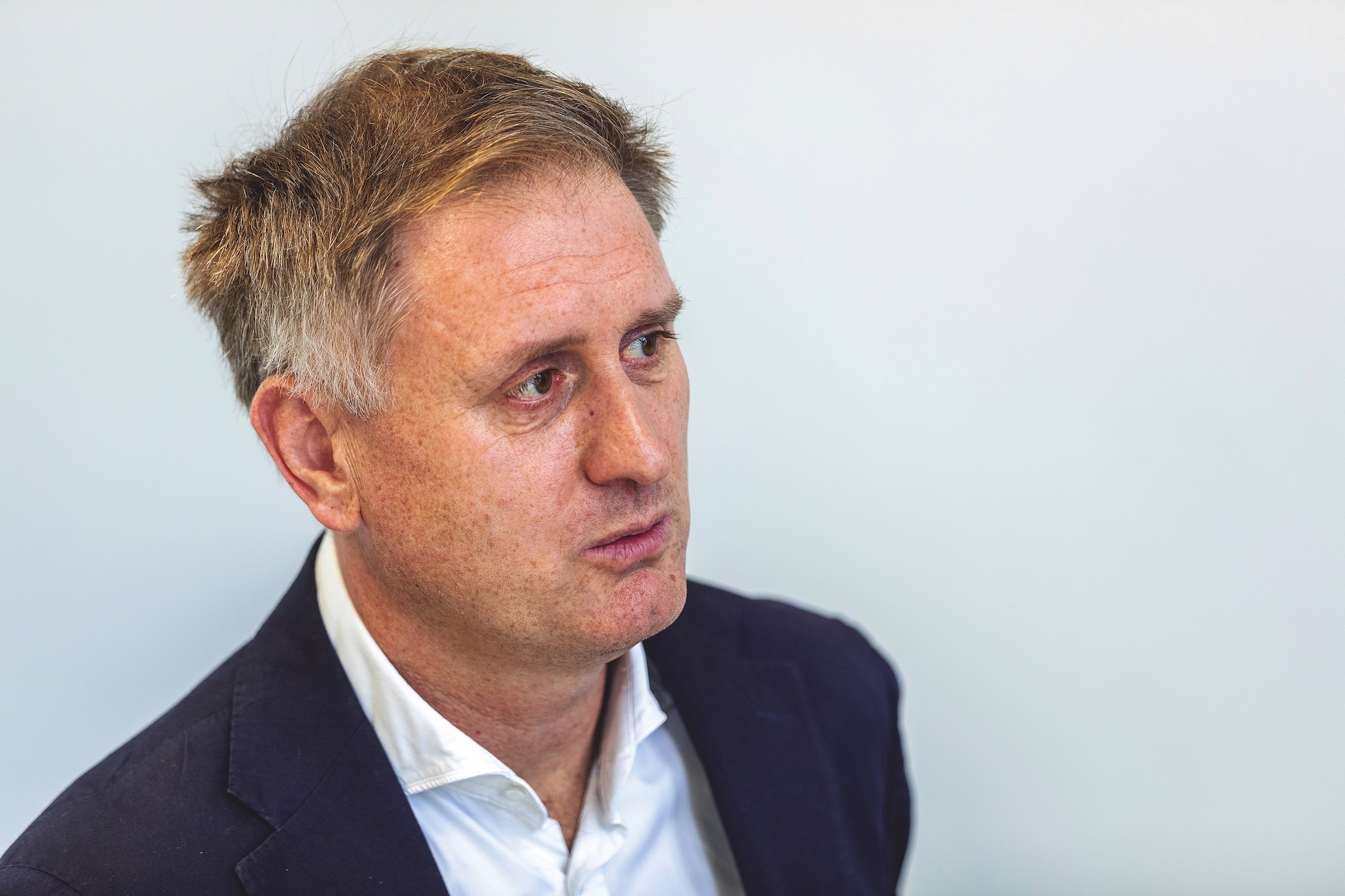“Nobody can do this on their own”
Angela Hillery, chief executive of community trusts in Northamptonshire and Leicestershire, is one of England most influential NHS leaders and a pioneer of collaborative working. She talks to Craig Ryan about why integrating services offers the best chance of overcoming a hostile environment and turning the NHS around.

“I didn’t have a plan to be a chief executive. I think people saw something in me that perhaps I didn’t see in myself,” says Angela Hillery. After starting her career as a speech and language therapist, she was encouraged “to dip a toe” into management. “It was then I realised that it was leadership that I loved.”
Running two community and mental health trusts—Northamptonshire Healthcare and next-door Leicestershire Partnership—Hillery is now seen as one of England’s most influential trust leaders and a pioneer of collaborative working. Twice named top NHS chief executive by the Health Service Journal, she was runner up in 2025.
We’re meeting at Berrywood Hospital, a modern psychiatric unit in a leafy suburb of Northampton. It’s one of 14 hospitals, as well as several health centres and other community facilities, which Hillery oversees as group chief executive.
Joining Northamptonshire in 2013, she led the then struggling trust to an ‘outstanding’ rating within five years. She was brought in to run Leicestershire in 2019, after the CQC found the trust’s leadership ‘inadequate’. Its ratings have improved since, but overall Leicestershire is still rated as ‘requires improvement’.
Culture change takes time, so stable leadership is important, she says. “You can’t do quick fixes or quick turnarounds. You’ve got to be prepared to live and breathe it, and when it doesn’t work out… you’ve got to be prepared to pick that up as well.”
Better together
The trusts have worked together—on staff programmes, quality improvement and strategy, for example—in a group arrangement since 2021, and Hillery has talked herself hoarse insisting they have no plans to merge. “It can be very distracting, very costly and you can create what you need without it”, she says.
Instead, she says, the glue holding the partnership together is a shared culture, which boils down to a common understanding “that people matter”. It’s culture that “drives the change… so we put a lot of energy into it,” she explains. Staff will only “go above and beyond” to deliver change if they feel “part of something they want to be part of. And that’s what we create.”
The benefits of working together have become “increasingly obvious”, she explains, and with the Leicestershire and Northamptonshire ICBs clustering—and possibly merging—it felt “natural” for the trusts to have a joint strategy.
The five-year plan, Together We Thrive, adopted this spring, sets out the group’s priorities, with heavy emphasis on tech, population health and inclusiveness. All fine and dandy, but what difference will it make on the ground? “I think you’ll see more integrated working,” Hillery says, with the trusts’ digital services “working more closely together to make sure we can share, learn and maximise efficiency,” as well as the group having “a bigger voice as a community mental health cohort.”
The strategy itself reads like it was written in response to the government’s Ten-Year Plan, rather than three months earlier. That’s “probably fortuitous”, Hillery says. With its strong record on collaboration and working with local populations to improve outcomes, she claims the group is ideally-placed to get involved in integrating neighbourhood teams and the planned multiple contracts for neighbourhood services. West Leicestershire has since been selected to join the first wave of 43 ‘places’ rolling-out new neighbourhood health services.
Different this time?
The Ten-Year Plan itself “is clearly ambitious, there’s a lot of intent there, but we have to remember it’s for ten years,” she says. Yes, the shift from hospitals to community services has been promised many times before—while money has actually moved in the opposite direction—but Hillery sees good reason to believe it might be different this time.
“This is the first time I’ve seen the policy direction supported by a range of workstreams to [achieve it],” she says. Work is in hand on new models of care, contract types and incentivisation systems, she understands. “All of those are necessary. In the past there’s been ambition, but the detail hasn’t come.”
She urges trusts and ICBs to “push and challenge for what we need to make it happen” rather than expect a national blueprint from NHS England. “We’ve got to do it locally,” she says. “It’s not one approach; it’s got to be a multitude of approaches and why can’t we pioneer some of those new elements and contractual forms?”
She’s enthusiastic, too, about promised new freedoms for foundation trusts. Foundation-status Northamptonshire and non-foundation Leicestershire “are dealt with pretty much the same from a regulatory point of view,” she says. She wants trusts—but only those “with firm foundations”—to take more responsibility for population health, while having freedom “to innovate, scale-up and deliver in partnership”.
The option for the “very best” foundation trusts to become ‘integrated care organisations’, holding the whole health budget for a defined population, clearly interests her, but “big questions” remain about how IHOs will work with other parts of the NHS system. But comparisons with American commercially-orientated ‘accountable care organisations’ are wide of the mark, she says. “It’s a completely different concept. My sense is it’s about taking responsibility for delegating resources, being a convenor or facilitator. It’s not about leading everything, it’s about improving outcomes in a cohesive and collective way.”
She sees a possible prototype for IHOs in the collaboratives the group has already set up, which have “created the conditions for people to want to work together,” she says. “It’s led us to do commissioning in the voluntary and community sector, to change crisis pathways and improve outcomes for people with learning disabilities and autism.”
The benefits of collaboration are visible, she says, in the transformation of CAMHS ‘Tier 4’ services—those for young people with the most complex mental health needs—where Northamptonshire leads for the East Midlands alliance of mental health trusts. By introducing a common waiting list and shared approach to prioritising need, a single clinical leadership and investing in community resources, the alliance has cut the number of beds needed across the region by more than half.
Northampton has also been successful in cutting waiting times for CAMHS referrals—a real bottleneck for many community trusts—from two years to 48 weeks, in a matter of months. “There’s no magic bullet,” says Hillery. Increasing access for specific population groups “has helped significantly”, as have partnerships with the voluntary sector and new models of care developed with local ICBs. In the long term, more mental health investment in schools will be “vital”, she says, “so those referrals coming through to [CAMHS] are the right ones. It’s that partnership thing again… nobody can do this on their own.”
A big ask
But the challenge of delivering such transformational change, while making eye-watering cuts to organisations already running hot, still looks daunting. Northamptonshire has 33,000 people on its mental health waiting list—4% of the county’s entire population—yet must cut costs by another 6.5% this year. A recent board meeting welcomed savings of £1 million in the first month of this financial year—before one director noted wryly that the target was double that.
“Yes, it’s a big ask,” says Hillery. Both trusts take a ‘value-based’ approach to efficiency, she explains, trying to concentrate resources on activity that produces the best outcomes for patients rather than cutting costs across the board. “That may be through integrating services, through transforming care, or around procurement.”
But Northampton’s board still identifies the threat to care quality and safety posed by the efficiency programme as the biggest risk facing the trust. Mitigating that means being “clear about what we’re commissioned to deliver”, says Hillery. “Inevitably… you can get some drift on those things. We’re prepared to innovate, but you have to balance it with safety… to ensure we’re not introducing more risk.”
Job losses are inevitable, Hillery admits, despite significant savings on agency spending. “Above all else, we’ve got to reduce the workforce—that’s the same for everybody,” she warns. She won’t say whether compulsory redundancies are on the cards—suggesting it depends on the outcome of the trusts’ efficiency drive—but in the absence of a nationally agreed and funded voluntary redundancy scheme, both trusts are introducing mutually agreed resignation schemes.
“People still want to be managers—that’s important”

“Absolutely, I see healthcare management as a profession”, says Angela Hillery. “There will inevitably be regulation but equally it comes back to development and understanding the competencies you [need].” She’s open-minded about sketchy government proposals for a new management and leadership framework. “Something that develops individuals and gives some consistency to access to support and resources… can only be a good thing,” she says.
She “hears the view” that uncompetitive pay, heavier workloads and threats of redundancy are making NHS management careers increasingly unattractive, but isn’t convinced. “Certainly, in my experience people still want to be managers… and that’s important,” she says. But “we can’t expect people to just manage. What are we doing to support these managers? How are we cross-fertilising?”
A multi-trust group like hers “can bring people together across complex organisations, and the more you bring [managers] together, the more chance you’ve got of keeping people wanting to do it,” she says.
She’s also big fan of mentorships and shadowing and is “actively supporting quite a few people at the moment”. When first stepping into a leadership job it’s important “to have a support structure so you’re not in an isolated position,” she says.
A leader’s job is “to create opportunities”, she adds. “That’s one of the key roles of a chief executive—not only to do it personally, but to create conditions where [organisations] can do that, through secondments and different system leadership opportunities.” | CR
The probably permanent increase in demand for some mental health services— particularly ADHD and autism, “which we’re more likely now to be aware of”, Hillery says—means the NHS will eventually have to get used to spending a bigger share of its budget on mental health (it’s now 9% and falling).
“We haven’t got parity. The mental health investment standard has been helpful but it’s still limited,” she says. More investment needs to come from outside the NHS too, she adds: “We need to push for more resources in schools and in local [communities] around mental health, and not assume everything needs to escalate into CAMHS or into a mental health organisation.”
Adding to the community
In such a hostile environment, what levers can chief executives like Hillery pull to improve services rather than just fight fires? “I firmly believe integrated care is the answer to that,” she replies. Outcomes won’t improve “if organisations stay separate”, she warns, and while there are good examples of integrated services, we need more “partnerships at scale”, as well as “a [clear] sense of what good outcomes look like” and much more use of population health data in planning services.
Hillery has long championed the ‘community asset’ model, which aims to build on a community’s existing strengths, relationships and resources to improve health outcomes. She sees the government’s ambitions for neighbourhood health centres as an endorsement of this approach, but admits “it needs more to bring it to life”.
She points to Leicestershire’s ‘neighbourhood cafés’—drop-in centres where locals can chat with staff trained “to listen and provide practical support”—as an example of this approach bearing fruit. “That develops a community asset because you’re sustaining the voluntary and community sector. You’re also reaching far more people, and your trust through those communities is massively [increased],” she explains. NHS organisations need to do more than just deliver services, she says. “It’s about what you’re adding to the community to build these assets.”
This means fully embracing ‘co-production’, says Hillery. “I think people [in the NHS] can say ‘co-production’ without really meaning it… It’s a much more mature way of working. It’s saying that we are genuinely equal in this.” The group’s collaboratives involve “people with lived experience” at every level, she explains. “It’s not a tokenistic approach; it literally holds us to account.” Co-production often works out cheaper in the long-run, she claims: “It’s actually very cost effective because you’re more likely to get the service meeting the need.”
Meaningful co-production can’t be done through a single group or advisory body, she says. The trust group has “people with lived experience delivering resources in our recovery centres”, she explains, peer support workers and a variety of representative bodies including a People’s Council and a Youth Advisory Board, as well as the trusts’ own governing bodies. “You can’t just have somebody who has lived experience and say that’s the only way,” she adds.
The fuzziness surrounding the Ten-Year Plan has left many NHS leaders scratching their heads about what to do next. But Hillery seems very clear-eyed and confident that her collaborative approach is the way forward, despite the daunting reality facing trusts like hers.
To get a “mandate” for change, we need “to change public perceptions of the NHS,” she says. “That’s a tall order, but we’re up for it. I feel very privileged to be leading organisations wanting to do that. I have that hope and optimism because of the people I work with.” //
Related Stories
-

Daniel Elkeles: “There’s a lot of green shoots here—the NHS is in a much better place”
As NHS Providers annual conference gets underway in Manchester, we speak to chief executive Daniel Elkeles about next year’s merger with the NHS Confederation and the future for NHS trusts in England. He tells Alison Moore that providers are “well placed” to deliver the Ten-Year Plan—but warns an unhappy workforce and a lack of investment could throw big spanners in the works.
-

We’ve given NHS management a home – we care for it and campaign for it
MiP is 20 years old this summer and its chief executive, Jon Restell, has been there since the beginning. He reflects on the union’s past, present and future in conversation with Healthcare Manager editor Craig Ryan.
-

“Showing kindness and trust creates a virtuous circle – people respond well to that”
As chief executive of Suffolk and North East Essex, one of England’s most highly rated integrated care boards, Ed Garratt has pioneered a radically different approach to leadership – one based around kindness, trust and putting down deep roots in local communities. He talks to Healthcare Manager’s Matt Ross.
Latest News
-

Government proposal for sub-inflation pay rise “not good enough”, says MiP
Pay rises for most NHS staff should be restricted to an “affordable” 2.5% next year to deliver improvements to NHS services and avoid “difficult” trade-offs, the UK government has said.
-

Unions refuse to back “grossly unfair” voluntary exit scheme for ICB and NHS England staff
NHS trade unions, including MiP, have refused to endorse NHS England’s national voluntary redundancy (VR) scheme, describing some aspects of the scheme as “grossly unfair” and warning of “potentially serious” tax implications.
-

Urgent action needed retain and recruit senior leaders, says MiP
NHS leaders are experiencing more work-related stress and lower morale, with the government’s sweeping reforms of the NHS in England a major factor, according to a new MiP survey.